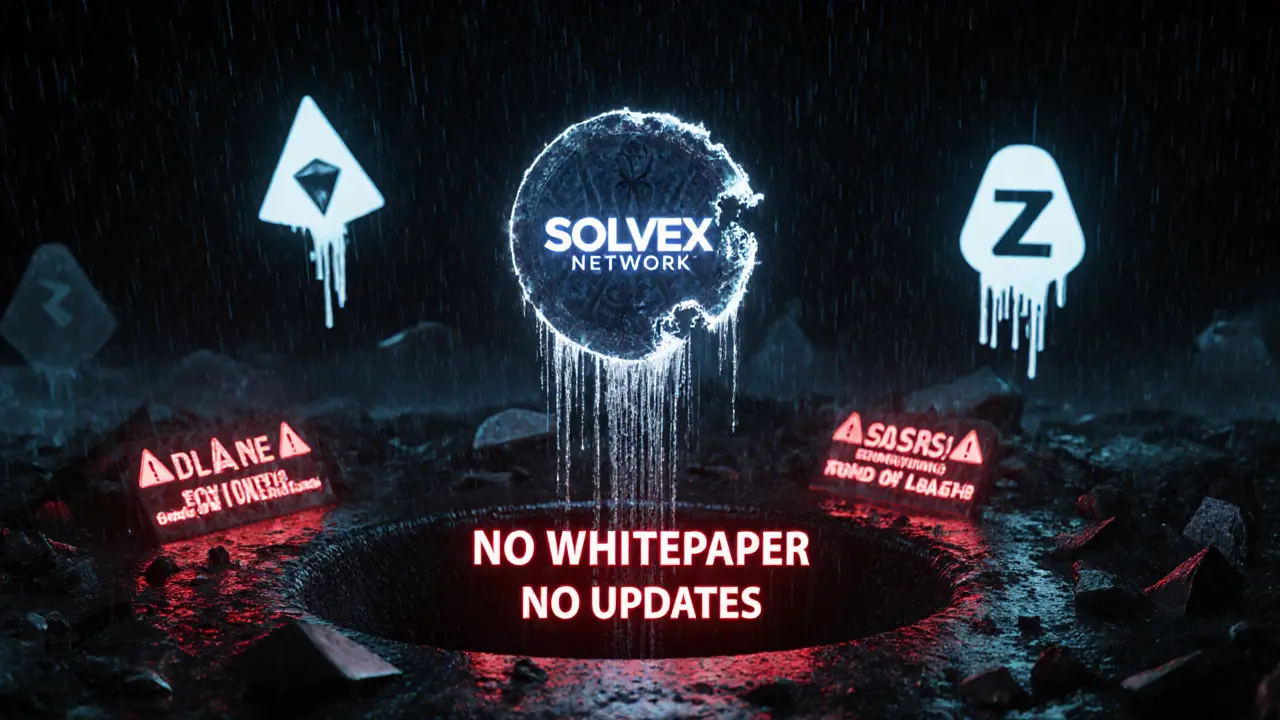SOLVEX Slippage Calculator
Based on the article, SOLVEX has extremely low liquidity with a 78.3% success rate on PancakeSwap (meaning 21.7% slippage). This calculator helps you understand how much you'll lose when trading due to this low liquidity.
Enter an investment amount to see results
Important: This tool uses the 78.3% success rate mentioned in the article (meaning 21.7% slippage). Actual slippage may be higher. SOLVEX has extremely low liquidity ($264,283 daily trading volume), making it very difficult to trade without significant price impact. Many users report failed transactions and unresponsive support.
There are thousands of crypto tokens out there, but few are as quietly fading away as SOLVEX NETWORK (SOLVEX). Launched in 2023, it promised to solve a real problem: how to make privacy-focused blockchain tech work within today’s strict financial regulations. Sounds smart, right? But behind the pitch, the reality tells a very different story.
What SOLVEX actually is
SOLVEX is a token built on the BNB Chain - the same network that powers Binance Coin and thousands of other small crypto projects. It has a fixed supply of 100 million tokens, meaning no new coins will ever be created. As of November 13, 2025, each SOLVEX token trades around $0.0233, giving it a total market value of roughly $2.33 million. That’s tiny compared to even the smallest established privacy coins. Its creators claim SOLVEX is different because it tries to balance two conflicting goals: strong user privacy and full regulatory compliance. That’s a tough sell. Most privacy coins like Monero or Zcash are designed to hide transaction details - something regulators hate. SOLVEX says it can do both, but there’s no public proof. No whitepaper with technical details. No audit reports. No mention of any legal partnerships or compliance certifications.How it performs - and why it’s struggling
On paper, SOLVEX looks like a speculative gamble. It’s down 5.27% in the last 24 hours, but up 1.8% over the past week - slightly better than the broader crypto market. But those small gains mean little when you look deeper. The 50-day moving average is at $0.0409, while the 200-day average sits at $0.1056. That’s a classic sign of a long-term downtrend. The token has been falling steadily since its peak in early 2024. Technical indicators like the RSI at 34.40 suggest it’s nearing oversold territory, but that doesn’t mean it will bounce. In fact, TradingView’s analysis gives it a strong “sell” rating across 1-week and 1-month charts. Liquidity is the biggest red flag. The 24-hour trading volume is just $264,283. For comparison, even obscure tokens on the same chain often trade over $1 million daily. That low volume means if you try to buy or sell a decent amount of SOLVEX, your trade will likely fail or move the price drastically. Users on DexScreener report a 78.3% success rate on PancakeSwap - far below the 95%+ you’d expect from any healthy token.Where you can’t find SOLVEX
You won’t find SOLVEX on Coinbase, Binance, Kraken, or any major exchange. It’s only listed on decentralized platforms like PancakeSwap. That’s not a feature - it’s a warning sign. Centralized exchanges have strict listing criteria. If SOLVEX can’t meet them, it’s because it lacks transparency, liquidity, or real demand. Even worse, its official website is bare-bones. Five pages of vague marketing fluff. No technical docs. No API references. No developer roadmap. CryptoCompare’s community survey found 87% of users rated the documentation as “inadequate.”
Community and development: Almost gone
A healthy crypto project has active developers, regular updates, and a growing community. SOLVEX has none of that. Its GitHub repository hasn’t had a meaningful update since March 2025. In the last six months, there were only three commits. That’s less than one update per two months - barely enough to fix a typo. Meanwhile, even small competing projects like Iron Fish are pushing weekly code updates. The official Telegram channel has 1,387 members. Most messages are from users asking for help. Admins haven’t posted anything in over a month. The Twitter account (@SolvexNetwork) last tweeted on September 4, 2025 - a claim about a “major exchange partnership” that never happened. Reddit users call it a ghost project. On CoinGecko, 12 out of 15 user reviews are negative. Common complaints: “Can’t trade without huge slippage,” “No updates since last year,” and “Support never replies.” One user waited 18 days for a response to a failed transaction - and got an auto-reply.Why experts say avoid it
Dr. Elena Rodriguez from Blockchain Insights Group put it bluntly in October 2025: “SOLVEX faces significant challenges in the crowded privacy coin space without a clearly differentiated technology or strong institutional backing, making sustainable growth unlikely.” CoinCodex analysts don’t just warn - they recommend shorting it. Their model suggests if you sold $1,000 worth of SOLVEX on November 13, 2025, and bought it back on December 25, you could pocket $304 in profit (before fees). That’s not speculation - that’s a calculated bet the price will keep falling. CryptoQuant forecasts a 68% chance SOLVEX drops below $0.0150 by Q1 2026. Dr. Michael Chen from Digital Asset Watchdogs calls it “a potentially abandoned project” based on its lack of development, broken promises, and dying community.
Is SOLVEX worth buying?
Let’s be clear: SOLVEX is not an investment. It’s a high-risk gamble with almost no upside. If you’re looking for privacy coins, Monero (XMR) and Zcash (ZEC) have been around for years, have active developer teams, and are traded on major exchanges. Even newer projects like Iron Fish have more community engagement and transparent roadmaps. SOLVEX offers no proven tech, no active development, no real community, and no exchange listings. Its only advantage is its low price - which makes it easy to buy, but not easy to sell. Many people buy it hoping for a pump, but when they try to cash out, they find there’s no one to buy from. The crypto market is full of projects that promise the moon. SOLVEX is one that quietly vanished before it even got off the ground.What happened to its roadmap?
SOLVEX’s website still lists Q3 2025 milestones: “mainnet launch,” “exchange listings,” “partnerships.” None of these happened. No delay announcements. No explanations. Just silence. In crypto, missed deadlines aren’t just disappointing - they’re deadly. Investors lose trust. Developers move on. Liquidity dries up. And once that cycle starts, it rarely reverses.Final verdict
SOLVEX NETWORK (SOLVEX) is not a cryptocurrency you should hold. It’s not even one you should trade unless you’re prepared to lose your entire stake. It lacks the technical foundation, community support, development activity, and market credibility to survive - let alone thrive. The low price makes it look like a bargain, but in reality, it’s a trap for anyone chasing quick gains. If you’re interested in privacy-focused crypto, look at projects with real code, active teams, and transparent roadmaps. SOLVEX has none of that. It’s a ghost in a crowded room - and everyone’s already left.Is SOLVEX a good investment?
No, SOLVEX is not a good investment. It has no active development, minimal community engagement, and no major exchange listings. Analysts and market data consistently rate it as high-risk or speculative, with strong indications it may be abandoned. The low price is misleading - liquidity is too low to trade safely, and the token has shown a long-term downward trend since its peak.
Where can I buy SOLVEX coin?
SOLVEX is only available on decentralized exchanges like PancakeSwap. It is not listed on any major centralized exchanges such as Binance, Coinbase, or Kraken. Trading on PancakeSwap carries high risk due to low liquidity - many trades fail or result in large slippage. Always use a trusted wallet and never invest more than you can afford to lose.
Why is SOLVEX’s price falling?
SOLVEX’s price is falling because the project has lost momentum. There’s no developer activity on GitHub, no updates to its roadmap, and minimal communication from the team. Trading volume is extremely low, making it hard to buy or sell without affecting the price. Market sentiment is bearish, with analysts recommending short positions and users reporting failed transactions and unresponsive support.
Does SOLVEX have real privacy features?
SOLVEX claims to offer privacy with regulatory compliance, but there is no public technical documentation to verify this. Unlike Monero or Zcash, which have transparent, audited privacy protocols, SOLVEX provides no whitepaper, no code audits, and no explanation of how its privacy system works. Without proof, these claims remain unverified marketing statements.
Is SOLVEX a scam?
There’s no legal proof SOLVEX is a scam, but it exhibits multiple red flags common in abandoned or rug-pull projects: no developer activity, broken promises, zero communication from the team, and declining community engagement. While not confirmed as fraudulent, its lack of transparency and active development makes it extremely risky - and effectively worthless as a long-term asset.
What’s the future of SOLVEX?
The future of SOLVEX looks bleak. With no development since March 2025, no exchange listings, and a dying community, the project shows no signs of revival. Analysts predict further price declines, with some forecasting it could fall below $0.0150 by early 2026. Unless the team suddenly releases a credible roadmap, hires developers, and builds real partnerships, SOLVEX will likely fade into obscurity.


Mike Calwell
November 15, 2025 AT 13:08lol this coin is dead. bought 10k solvex last year, now it's worth less than my coffee.
Jay Davies
November 16, 2025 AT 18:09Actually, the liquidity metrics here are textbook for a dying asset. Trading volume under $300k on a $2.3M market cap? That’s a death spiral waiting to happen. No major exchange listing, zero dev activity - it’s not even a rug pull, it’s just a silent extinction.
Barbara Kiss
November 17, 2025 AT 01:31There’s something haunting about projects like this - not because they’re evil, but because they were once someone’s dream. A team sat down, believed they could reconcile privacy and compliance, and poured their soul into code that never saw the light. Now it’s just a ghost in the blockchain graveyard, with bots scraping its last 264k in volume like vultures. We don’t need to hate it. We just need to let it rest.
Aryan Juned
November 18, 2025 AT 03:22OMG this coin is so last season 😭 Like who even still talks about SOLVEX?? I saw a guy on Twitter try to dump 500k tokens and the slippage was 47% 💀 Bro, you didn’t lose money - you funded someone’s crypto funeral. RIP SOLVEX 🕯️ #crypto #ghostcoin
Nataly Soares da Mota
November 19, 2025 AT 08:03What’s fascinating is the epistemological vacuum here. SOLVEX purports to be a privacy-compliant chain, yet offers zero ontological grounding - no whitepaper, no audit trail, no cryptographic primitives disclosed. It’s not a blockchain; it’s a semantic placeholder, a linguistic artifact masquerading as a financial instrument. The market’s rejection isn’t irrational - it’s a necessary corrective to semiotic fraud.
Teresa Duffy
November 19, 2025 AT 20:26Y’all need to stop feeding these ghost coins. I’ve been in crypto since 2017 and I’ve seen hundreds of these - the low price is the trap. Don’t get fooled by the ‘bargain’ label. If no one’s buying, you’re the last one holding the bag. Go invest in something real. You deserve better than this.
Sean Pollock
November 20, 2025 AT 08:05lol so SOLVEX is just a scam? i knew it! i told my bro not to buy it but he said ‘it’s cheap so it’ll pump’ 🤡 dumbass. also the website looks like it was made in 2015 on wix. no dev activity since march? bro that’s not a project, that’s a digital corpse. also why does the telegram have 1k members but all posts are ‘help pls’? 🤦♂️
Carol Wyss
November 21, 2025 AT 07:31I know it’s easy to just call it a scam, but I feel bad for the devs who probably believed in this. Maybe they got overwhelmed, ran out of funds, or just burned out. It’s sad when passion projects die quietly like this. If you’re holding SOLVEX, don’t beat yourself up - just cut your losses gently and move on. You’re not dumb for believing. The system is just rigged.
Student Teacher
November 22, 2025 AT 05:07Wait - if the 50-day MA is $0.0409 and the current price is $0.0233, that’s a 43% discount to the short-term trend. But with RSI at 34 and volume this low, is it really oversold or just collapsing? Could this be a liquidity trap disguised as a technical bounce? I’m trying to understand if there’s any signal here or just noise.
Ninad Mulay
November 23, 2025 AT 08:34Back in India, we call these ‘ghost coins’ - the ones that glow on DexScreener but have no heartbeat. I saw one like this last year - ‘MangoCoin’ - same story. Low price, zero updates, Telegram full of panic. Now? Worth 0.000001. Don’t fall for the ‘bargain’ vibe. If the devs aren’t talking, they’re gone. Walk away. Save your gas fees for something that breathes.
Grace Craig
November 23, 2025 AT 23:56The structural deficiencies of SOLVEX are not merely operational but systemic. Absent a verifiable technical architecture, a transparent governance model, or institutional validation, the asset cannot fulfill the fiduciary function expected of a cryptographic instrument. Its continued existence in market data feeds is a testament to the inefficiencies of decentralized exchange liquidity pools, not to any intrinsic value.
Ryan Hansen
November 24, 2025 AT 11:03Let’s be real - this isn’t even about SOLVEX. It’s about how crypto has become this giant carnival of hope and hype. People see a token at $0.02 and think, ‘I can buy 10 million of these!’ But they don’t see the 99.9% of tokens like this that just evaporate. They don’t see the abandoned GitHub repos, the silent Telegram groups, the fake exchange announcements. It’s not that SOLVEX is bad - it’s that the whole ecosystem is designed to let these things exist until they collapse, and we’re all just watching the slow-motion train wreck. And we keep clicking ‘buy’ anyway.
Derayne Stegall
November 24, 2025 AT 13:58STOP BUYING THIS COIN 😤 I’m telling you - if you’re still holding SOLVEX, you’re basically paying to keep a dead website alive. Sell it. Now. Then go buy some ETH or SOL and actually sleep at night. 🚀💸 #crypto #dontbelieveinghosts
Bruce Murray
November 26, 2025 AT 12:05Even though the data shows SOLVEX is basically dead, I still believe in the idea behind it - privacy + compliance. Maybe the team just needed more time. I’m not selling. I’m holding. Not because I think it’ll pump, but because I believe in the vision. Someone’s gotta keep the flame alive, right? 🌱